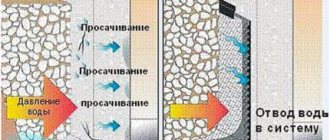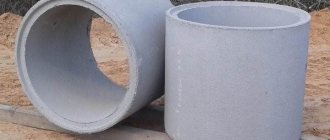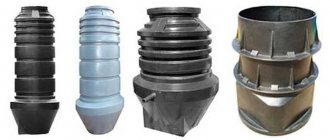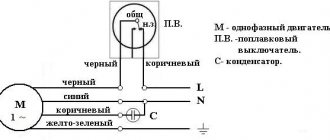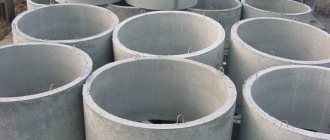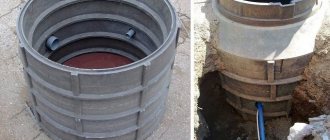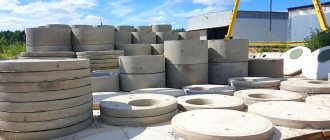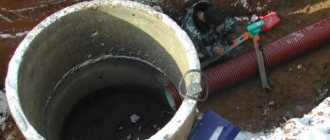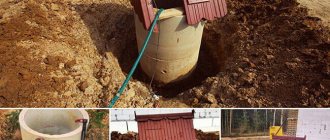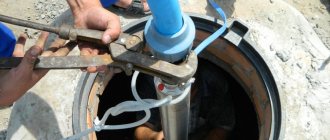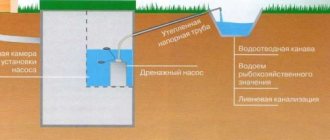Here you will learn:
- Description and features of reinforced concrete rings
- Pros and cons of reinforced concrete rings for constructing wells
- What is the structure made of?
- Types of concrete well rings
- Table of sizes of reinforced concrete rings for a well
- Which manufacturer to choose
- Ring prices
- How to install correctly
Reinforced concrete rings for wells are a multifunctional material used in various fields of construction. Their versatility is due to excellent performance, resistance to mechanical stress, as well as a wide range of standard sizes. The sizes of concrete rings for wells can vary from 0.7 to 2 meters.
Description and features of reinforced concrete rings
Based on the name, it is clear that the reinforced concrete ring consists of metal and high-quality concrete. This makes it durable and allows it to resist loads from the outside and inside. External loads mean the soil pressure on the ring. As for the internal loads, this is the water that the rings hold back, preventing it from getting into the ground.
The latter is especially important when installing septic tanks and drainage pits. The rings undergo additional waterproofing, which makes them completely sealed. The reinforced concrete rings in the photo have the shape of a cylinder.
Well rings, also known as reinforced concrete products, are available on the market in different diameters. This expands the scope of application of the material, allowing it to be used for the needs of private developers and capital construction. Such rings weigh quite a bit, so you won’t be able to deliver them yourself.
Basically, for their delivery, a manipulator is used, which simultaneously delivers them to the site and independently unloads and performs installation. For installation and unloading, each ring has special hooks. They are part of reinforced concrete structures, so the geometry of the ring itself is not disrupted during unloading.
The rings come complete with a bottom and a top cover. This allows you to achieve maximum tightness, comply with SNiP standards, and install the septic tank correctly.
Types of reinforced concrete modules
The simplest standard models are produced without additional fasteners. Their end resembles a smooth, even rim both at the top and at the bottom.
When laying, they are placed one on top of the other and fastened with metal brackets. The joint area is covered with cement mortar or dry repair mixture.
A hydraulic seal can be used as a sealant for well rings. The material consists of a special grade of cement and quartz sand. It hardens quickly and expands over time. Protects reinforced concrete mains from sewage penetration
After such treatment, the system acquires optimal integrity and tightness. Correct insulation in the contact area of concrete elements extends the operational life of the shaft and almost completely eliminates water leakage through the cracks between concrete elements.
Despite their reliability and strength, standard rings without a lock are suitable for installation in regions with low seismic activity. Strong ground movements can lead to displacement of modules and cracking of cement in the joint area
Euro-rings are available with a practical milling-type locking connection. There are protrusions at the top of such products, and deep recesses at the bottom.
During installation, the elements are inserted into each other, thus providing a monolithic and strong connection that does not require additional processing in the joining area.
When purchasing well rings with an end lock, you should carefully monitor their quality. Poorly cast joining parts will complicate the work and require the use of diamond cutting to eliminate errors and imperfections
This facilitates and speeds up the process of creating a communication system and reduces the overall financial costs of the project. A well shaft made of Euro-rings with a lock is not afraid of seismic activity with shears and maintains the integrity of the structure even on very unstable soils prone to subsidence.
A monolithic glass is a one-piece structure made of a row ring and a bottom. Used in places with increased requirements for tightness, for example, for sewer tanks. Provides a high level of protection to the surrounding soil and does not allow the contents of the well to seep into the ground or enter groundwater.
Pros and cons of reinforced concrete rings for constructing wells
Concrete is convenient due to the following characteristics:
- Sizes – wide choice of models.
- Concrete grades and additives can be selected so that they can withstand high loads, humidity and freezing.
- The products do not require special treatment or care.
- Long service life - up to 100 years.
- Easy to install.
- It is possible to produce concrete components directly on site on your own.
- Low cost.
The disadvantages may be:
- Large section weight.
- The need to use a crane during installation.
- If installed incorrectly, it will be difficult to waterproof the connections.
- Problems with dismantling and replacing sections.
What is the structure made of?
Supporting reinforced concrete sections for wells can be a combination of a bottom slab and a stacked top. But the tightness of the connection between them will be problematic. This seam, which is the deepest, will be subject to the greatest stress. Solution: instead of two products, take one - a structure with a bottom. Having the shape of a glass, it goes into the shaft first. This bottom can withstand heavy loads. Height – from 300 to 1,000 mm. Marked with the abbreviation KCD, they can be flat or chamfered at the end.
Above, standard high sections (HS) are mounted one on top of the other, sealing the connection. If it is necessary to bring the structure to the desired level, they are complemented by an additional ring, characterized by a low (up to 400 mm) section (standard heights 100, 150, 300 mm). Additional parts are marked according to structure: K (type), D (inner diameter, cm), H (height).
Well sections with a lock - do not have a smooth end, but are equipped with a chamfer (there is a recess on one edge, and a protrusion on the opposite). Such a factory-made part greatly facilitates installation and sealing of the connection.
In operation, a reinforced concrete barrel with a lock is more resistant to deformation under lateral loads. Under reinforced concrete, the locks have metal embedded parts welded to the reinforced frame.
Fastening brackets, as well as plates with bolts, are used for connecting reinforced concrete products. Structures with a lock require additional strengthening on moving, freezing soils.
Uneven loads that occur in autumn and spring are especially dangerous for a well (the lower layers of the soil freeze in a peculiar way and thaw later than the upper ones).
The shape of the staples can be different (H-shaped and more complex). They are made of steel 5 mm thick, the width of the element is up to 8 cm. For each connection, 3 pieces are enough.
The well needs running brackets for maintenance and visual inspection of its condition. A metal running bracket made of stainless steel or coated with plastic is placed into the product during casting or mounted afterwards (in the provided mounting holes or drilled ones) on dowels. They are installed at a distance of 300 mm from each other. The joints between the brackets and the pipe walls are sealed with cement.
Advantages and disadvantages of reinforced concrete products
Well rings made of reinforced concrete are very popular and are included in the list of the most popular building materials. This is due to their specific physical and structural characteristics.
The main advantages of the product include:
- Extended operational period. Concrete reinforced with steel wire is neutral to any environment, including aggressive ones, and, according to manufacturers, can last at least 100 years.
- Maintaining rigidity and structural integrity on active soils. Wells made of reinforced concrete rings are installed even in areas with seismic activity up to 8 points.
- Wide range of models . Products are available in a variety of sizes. This makes it possible to select suitable reinforced concrete products for any purpose and need.
- Pronounced frost resistance. It is ensured by a strong bond between the reinforcing elements and the concrete mixture, which occurs after the final drying of the workpiece.
- High tightness. The seams fit tightly together at the joints and prevent the penetration of groundwater and other foreign substances or materials.
Finished products are sold at the best price and are suitable for arranging communication networks of any scale.
In the process of producing a well from reinforced concrete rings, it is necessary to strictly adhere to the installation rules. Incorrect installation will lead to uneven load on the walls and in the future will provoke the appearance of cracks throughout the pipeline
Disadvantages include the weight and dimensions of the product. Transportation and installation require professional equipment with good power and a team of craftsmen.
This inevitably entails additional material costs and an increase in the total cost of installation work.
You can make reinforced concrete rings for installing a small well in your country house with your own hands. The homemade production technology is described in detail in the following article, which we highly recommend reading.
Types of concrete well rings
Concrete rings are used in the construction of wells for various purposes. Drinking, sewer, waste columns, settling tanks, and reservoirs are collected from them. They are also used to build sewer settling tanks and septic tanks. GOST 8020-90 defines all types of products for the manufacture of networks and wells in particular. Not all of them are used in everyday life. The most commonly used types of rings are:
- KS - wall or through ring. It is a concrete cylinder. Installed one on top of the other, they form a well column. They come in different diameters - from 70 cm to 200 cm, with a wall thickness from 5 to 10 cm. They can be: ordinary with a smooth edge, standard wall thickness;
- with a formed projection - for a locking joint;
Concrete rings for the walls of wells can have a seam edge - this is when a protrusion is formed for the locking connection
- reinforced - with a large wall thickness for deep cases;
- reinforced - with inserted reinforcement.
According to the standard, the walls of the rings can have a technological slope of no more than 1.5%. But at the same time, the wall thickness and internal diameter at the middle of the height must coincide with the standard ones. In general, smooth walls, the absence of cavities and cracks are a sign of normal quality.
Floor and base slabs
Even when constructing wells, slabs may be needed. Some of them are placed on the bottom, others are covered on top. When constructing drinking wells, concrete slabs are not often laid - more often they make a house for the well. When assembling septic tanks from well rings, the base slab is often poured rather than laid ready-made. So you can do without these products, but their use reduces the work time. In general, GOST has the following types of slabs for wells:
- PN - bottom plate. This is a flat round pancake that is placed at the bottom of a dug pit.
- PO - support plate. It is a rectangular plate with a round hole in the center. It is used to cover a well if a rectangular rather than a round platform is required on top.
Types of floor slabs for wells
- PD - road slab. Similar to software, only it has rectangular dimensions and greater thickness. Place it on the top ring of the well if it faces the roadway.
- PP floor slab. This is a round pancake with a round hole for the hatch cover. The hole is shifted to one of the edges for easier access.
Standard sizes for slabs
The standard allows for bevels on the side edges of slabs made in one-piece molds. But the quality of concrete, the absence of cracks, cavities and other serious flaws - all these are signs of normal quality.
How to choose a well size
When you have decided on the design of the well, you know what kind of bottom you want, how and with what you will cover the well, the most important thing is to decide on the size of the well. All other elements are of the same size. They are designed to fit one to the other. And the number of links is determined based on the required volume or is approximately calculated based on the depth of the aquifer. For sedimentation tanks, septic tanks, storm wells, they are calculated based on the required storage volume.
The dimensions of well rings of all types must match
If we talk about drinking wells, they are assembled from KS with a diameter of 100 mm (KS-10) to 150 mm (KS-15). A ring with a bottom or a bottom slab is not installed - open access to the aquifer is required. When assembling a well for drainage, a sump tank or a septic tank, it is better to take the lower link immediately with the bottom - both the installation is simpler and the tightness is ensured. Another option is a bottom plate and a KS or KO ring installed on it. KO is placed if there is a need to make the lower part heavier.
What types of rings are there for a drinking well?
There is no single standard that regulates the sizes of rings for wells. To line a well shaft, rings with an internal diameter of 90-100 cm and a height of 70-100 cm are used. These values are dictated by practicality: if you take less, it will be inconvenient to dig inside, if more, the amount of manual labor will increase significantly. The larger the ring, the heavier it is, which means additional shipping costs.
Concrete rings, indistinguishable from the outside, differ in casting technology and composition:
- Drinkable;
- Sewer;
- Gas pipelines.
The most stringent requirements are imposed on water intake rings. Each ring must have a standard marking. Before going on sale they are subjected to production tests.
You need to order reinforced concrete rings only from certified sellers. Under the guise of well products, you can unknowingly buy simple technical ones, which contain harmful impurities
High-quality reinforced concrete rings have many advantages:
- Lowest price (in comparison with a wooden frame or rubble masonry);
- Solidity;
- Easy to install and repair;
- Resistance to soil pressure;
- Wide range.
For strong and durable well concrete rings, a frame made of reinforcement is used, filled with a mortar of M-500 cement. The wall thickness is from 10 cm.
When producing rings for non-food purposes, casting molds are lubricated with petroleum products. Along with them, an oil film may appear in the new drinking well, which is not easy to get rid of.
In industrial production, vibration is used to compact the solution in the molds, but the surface of the finished ring retains some porosity, so it is impossible to completely clean it of oil.
Table of sizes of reinforced concrete rings for a well
| K-10-10 | 1160 | 1000 | 990 | 80 | 0.27 | 0.68 |
| K-10-5 | 1160 | 1000 | 490 | 80 | 0.14 | 0.35 |
| K-12-10 | 1410 | 1250 | 990 | 80 | 0.33 | 0.82 |
| K-12-5 | 1410 | 1250 | 490 | 80 | 0.17 | 0.42 |
| K-15-10 | 1680 | 1500 | 990 | 90 | 0.44 | 1.1 |
| K-15-5 | 1680 | 1500 | 490 | 90 | 0.22 | 0.55 |
| K-20-5 | 2200 | 2000 | 490 | 100 | 0.33 | 0.82 |
| K-7-1.5 | 840 | 700 | 145 | 70 | 0.024 | 0.06 |
| K-7-10 | 840 | 700 | 990 | 70 | 0.17 | 0.42 |
| K-7-5 | 840 | 700 | 495 | 70 | 0.084 | 0.21 |
| KS 7.6 | 840 | 700 | 590 | 70 | 0.3 | 0.25 |
| KS10.18a | 1160 | 1000 | 1790 | 80 | 0.46 | 1.15 |
| KS10.3 | 1160 | 1000 | 290 | 80 | 0.08 | 0.2 |
| KS10.6 | 1160 | 1000 | 590 | 80 | 0.16 | 0.4 |
| KS10.9 | 1160 | 1000 | 890 | 80 | 0.24 | 0.6 |
| KS10.9a | 1160 | 1000 | 890 | 80 | 0.22 | 0.55 |
| KS13.6 | 1410 | 1250 | 590 | 80 | 0.2 | 0.5 |
| KS13.9a | 1410 | 1250 | 890 | 80 | 0.28 | 0.7 |
| KS13.9b | 1410 | 1250 | 890 | 80 | 0.24 | 0.6 |
| KS15.18 | 1680 | 1500 | 1790 | 90 | 0.804 | 2.01 |
| KS15.18a | 1680 | 1500 | 1790 | 90 | 0.75 | 1.88 |
| KS15.18b | 1680 | 1500 | 1790 | 90 | 0.72 | 1.8 |
| KS15.6 | 1680 | 1500 | 590 | 90 | 0.265 | 0.66 |
| KS15.6b | 1680 | 1500 | 590 | 90 | 0.22 | 0.55 |
| KS15.9 | 1680 | 1500 | 890 | 90 | 0.4 | 1 |
| KS15.9a | 1680 | 1500 | 890 | 90 | 0.35 | 0.88 |
| KS15.9b | 1680 | 1500 | 890 | 90 | 0.32 | 0.8 |
| KS20.12a | 2200 | 2000 | 1190 | 100 | 0.67 | 1.68 |
| KS20.12b | 2200 | 2000 | 1190 | 100 | 0.64 | 1.6 |
| KS20.18b | 2200 | 2000 | 1790 | 100 | 1.02 | 2.55 |
| KS20.6 | 2200 | 2000 | 590 | 100 | 0.39 | 0.98 |
| KS20.6b | 2200 | 2000 | 590 | 100 | 0.3 | 0.75 |
| KS20.9 | 2200 | 2000 | 890 | 100 | 0.59 | 1.48 |
| KS20.9b | 2200 | 2000 | 890 | 100 | 0.44 | 1.10 |
| KS25.12a | 2700 | 2500 | 1190 | 100 | 0.87 | 2.18 |
| KS25.12b | 2700 | 2500 | 1190 | 100 | 0.76 | 1.90 |
| KS25.6 | 2700 | 2500 | 590 | 100 | 0.48 | 1.2 |
| KS7.3 | 840 | 700 | 290 | 70 | 0.05 | 0.13 |
| KS7.9 | 840 | 700 | 890 | 70 | 0.15 | 0.38 |
| KTs12.9 | 1410 | 1250 | 290 | 80 | 0.30 | 0.75 |
| KTs25.12 | 2700 | 2500 | 1190 | 100 | 0.97 | 2.42 |
| PK-7S | 870 | 650-670 | 360 | 100-110 | 0.036 | 0.09 |
Which manufacturer to choose
In the Russian Federation, about 250 manufacturers are engaged in the production of reinforced concrete rings, covering the entire territory of the country. Therefore, traveling outside your region in search of cheap prices is not economically profitable. The savings will be consumed by transportation. However, the products of some factories are in special demand. We can highlight:
- "VTG Stroy" in Mytishchi, Moscow region, shipping its products throughout the country. Their KS 10.9, KS 15.9 and KS 20.9 rebated and flat models complete with a lid and hatch are in particular demand. The average cost is 2.1 thousand rubles.
- OJSC "Plant of Industrial Construction Parts", operating for more than 45 years in Tyumen. It has its own accredited construction laboratory, which allows not only to monitor quality, but also to develop new technologies.
- in Novokuznetsk is a supplier of high-quality reinforced concrete products throughout the Kemerovo region. In addition to producing standard designs, the company is also willing to accept orders for individual projects.
- in Krasnodar is distinguished by a wide range and high production capacity. Prices for reinforced concrete products start from 1.4 thousand rubles.
These manufacturers strictly monitor production technology and guarantee the quality of their products.
What else is worth considering
There is one more factor that should not be overlooked - the presence of special connecting grooves, or, as they are also called, well ring locks. Thanks to this system, assembly of the structure is much easier. In addition, the well is stronger and more resistant to the deforming action of soil layers.
Unlike rings with straight ends, the process of sealing seams is much simpler: just mix a special solution as recommended in the instructions and seal narrow gaps at the joints.
Advice! Quarter rings are much more ergonomic to use, and if you start making a well yourself, it is better to choose this option.
Ring prices
The pricing policy is determined by the market, and therefore in different regions the same product will cost differently, but everywhere its price is directly dependent on the size. And if for KS 7.3 you will have to pay from 700 rubles, then for KS 20.9 - already about 4.5 thousand rubles. Purchasing from the manufacturer provides savings of 5-15% compared to construction markets. But when drawing up an estimate, in addition to spending on rings, the customer must keep in mind other expenses:
- digging a foundation pit for a structure;
- for delivery of products;
- for installation work;
- construction of a well house (optional);
- for additional materials, for example, cement for sealing joints or pebbles for the filtration bottom of a well.
It makes sense to cooperate with one supplier. In many cases, this will bring additional benefits in the areas of service, delivery and information support.
What to choose - concrete or plastic wells?
In recent years, special plastic rings for wells have appeared on the building materials market. They are lightweight and easy to install. However, their price is significantly higher than that of conventional concrete rings. Therefore, it cannot be said that they have replaced proven technology or will do so in the foreseeable future.
So, if you are interested in digging or deepening a well from concrete rings, as well as installing formwork, in most cases it makes sense to use concrete rings.
How to install correctly
It is difficult to install reinforced concrete rings with your own hands, but sometimes this is done due to the impossibility of special equipment access to the territory. Otherwise, you buy reinforced concrete rings at the construction site, hire a manipulator, and he performs loading, delivery to the customer’s site, and unloading. Unloading can be understood as direct installation.
Before installation, experts recommend going deep to the required depth, compacting the bottom, and adding a cushion of sand. Concrete will draw moisture from the ground, so a pillow is simply necessary. Do not skimp on this layer, and fill up to 10 centimeters of sand, inclusive. To some extent, this will level the base. Place a concrete bottom on the sand, then begin the phased installation of the rings.
Each of them has special hooks. They serve to secure the manipulator slings and to connect the rings together. After the first reinforced concrete product is lowered, the slings are released, the metal hooks are bent, and the second product is installed. Then, all the screams can be linked together using a welding inverter. The work is not difficult and even a novice welder can handle it.
When a well is being constructed and the work is done manually, it is not always possible to use the services of a manipulator. In this case, install the first ring and gradually dig inside it, which allows the rings to fall down.
Next, when the first one is lowered to its own height and stands parallel to the ground at the top, the second reinforced concrete product is installed and work continues in the same way. Experts recommend using a hole drill, with the ability to drill to a depth of 10 meters or more.
This will allow you to drill through the entire internal diameter, install the ring and dig manually only under its walls. You will save the required amount of time and get the job done professionally. To make your work easier manually, you will need a powerful winch. It should be firmly fixed, which will facilitate the process of raising and lowering the products.
Which ones are better and how to determine quality
There are two technologies for the production of concrete rings: vibration casting and vibration pressing. In the first case, concrete is poured into collapsible molds, compacted with a submersible vibrator and left until it sets. This usually happens after 6-8 hours. Then the molds are removed and the rings are left to “ripen” so that they gain enough strength for sale - 50%. They can be installed in 28 days, so it’s better not to buy “fresh” rings. Another point: in the last days of ripening, cracks may appear. So it is best to purchase well rings that have been “aged” in a warehouse. As you can see, the technology is simple; apart from the forms, there is no equipment. This allows us to open small workshops that make these products. In this case, the quality depends entirely on who mixes and pours the molds.
You need to choose based on the quality of the walls and edges, the absence of defects and deviations in size
To produce well rings using vibrocompression, special equipment is required. Not only the forms, but also the brick making machine itself. It creates a certain pressure and vibration frequency at each stage of the process. The result is more uniform concrete, smooth and even edges, and a perfectly formed edge or lock. But the price is also higher - more expensive equipment.
